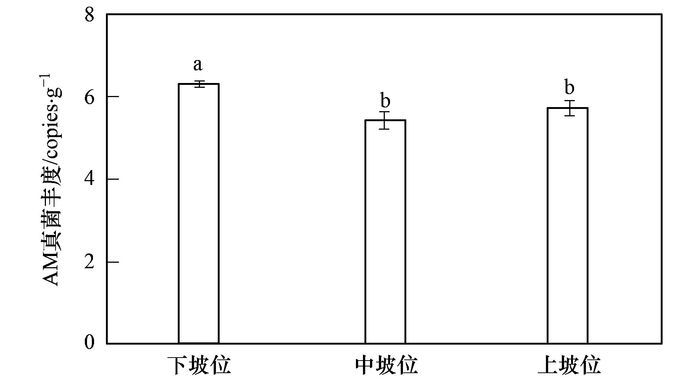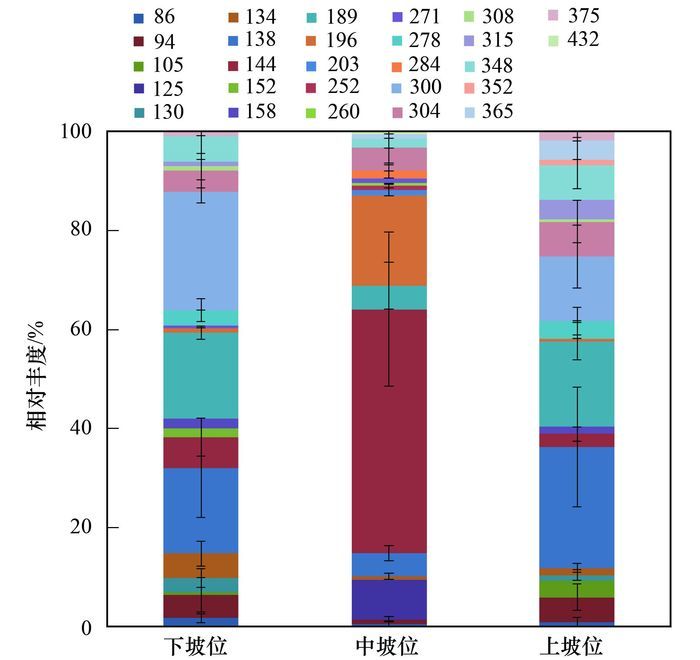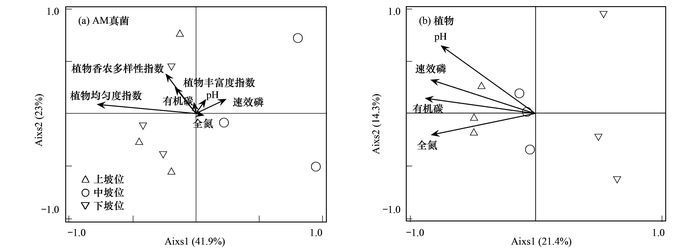2. 中国地质科学院岩溶地质研究所, 国土资源部、广西壮族自治区岩溶动力学重点实验室, 桂林 541000
2. Key Laboratory of Karst Dynamics, Ministry of Land and Resources & Guangxi Zhuangzu Autonomy Region, Institute of Karst Geology, Chinese Academy of Geological Sciences, Guilin 541000, China
AM真菌能够与陆地生态系统90%以上的植物形成共生关系[1].这种共生关系是建立在互惠互利的基础上, 如植物为AM真菌提供碳水化合物, 而AM真菌促进植物吸收氮磷养分[2].有研究表明, 在养分贫瘠土壤中, AM真菌会加强与植物共生关系, 促进植物吸收养分[3], 从而促进植物在养分贫瘠土壤中的定殖及生长[4].此外, Van Der Heijden等[5, 6]报道了植物多样性、生产力与AM真菌多样性呈正相关关系.因此, AM真菌在植被恢复中显示其巨大的潜力.
AM真菌是直接联系植物与土壤的载体, 对植物与土壤理化性质变化反应灵敏.已有的研究表明, AM真菌具有宿主专一性[7], 不同森林生态系统土壤中AM真菌群落结构存在显著差异[8].同样, 土壤理化性质显著影响AM真菌群落组成结构与多样性.不同生态系统中, 土壤速效磷是驱动AM真菌群落结构组成的主要因子[9, 10].此外, Aliasgharzad等[11]的研究表明草丛生态系统中pH也显著影响AM真菌群落结构组成及多样性.因此, 综合分析植物与土壤因素对AM真菌群落的影响, 能够更加合理的调控AM真菌用于植被的恢复.
喀斯特地区约占地球陆地表面积的15%, 中国西南喀斯特地区面积约550 000 km2, 是世界上最大的喀斯特区域[12].喀斯特地区独特的穴洞、落水洞等地貌[13], 导致了该地区生态环境脆弱且对人为干扰敏感.上世纪50~90年代, 人口剧增及对资源的过度开采进一步加剧了该地区的石漠化[14].因此, 喀斯特地区退化土壤的恢复刻不容缓.灌丛植物在喀斯特地区具有分布广、旱生、适钙等特点, 从而成为该地区植被恢复的关键阶段.已有研究表明, AM真菌在退化土壤恢复中起重要的作用[5, 6].虽然已有研究报道了喀斯特地区AM真菌种质资源丰富[15], 目前, 该地区对AM真菌的研究主要集中在提高植物抗旱性上[16, 17], 但应用于植被恢复还处于起步阶段.冯书珍等[18]的研究表明, 不同坡位条件下, 土壤微生物群落结构存在显著差异.在喀斯特灌丛生态系统中, 不同坡位条件下, 土壤养分与植物群落组成结构存在显著差异[19], 土壤AM真菌群落结构如何变化的研究未见报道.因此, 本研究运用T-RFLP与Q-PCR的方法研究喀斯特灌丛生态系统不同坡位条件下土壤AM真菌群落结构与丰度, 探讨土壤性质、植物群落组成与AM真菌群落结构、丰度之间的关系, 以期从微生物学的角度为喀斯特地区植被恢复提供理论依据.
1 材料与方法 1.1 研究样区研究样区同进村(24°50′N, 105°55′E)位于广西壮族自治区环江毛南族自治县西北部, 属于亚热带季风气候, 年均气温10.1~28℃; 年均日照时数1 451 h; 年均降雨量1 389.1~1 750 mm, 空气平均相对湿度为79%, 成土母质为白云岩发育的石灰土, 灌木群落有15~20 a的退耕历史.
1.2 植被调查与土壤样品采集植被调查:2012年6月, 在研究区从山顶到山脚布设3条样带, 每条样带分别在样带的上、中、下坡位布设3个样方(10 m×10 m), 一共9个样方(9为3个坡位×3个重复), 每个样方距离100 m.将每块灌木样方分成面积相等的4个小样方调查植被组成, 每个小样方分成2层(灌木层、草本层)进行调查. 2.5 cm<胸围<3.14 cm为灌木, 胸围<2.5 cm为草本.同时, 记录每种植物的坐标、高度、冠幅、株数.
土壤样品采集:考虑到喀斯特地区土壤异质性高, 为了得到具有代表性的土壤样品, 每个样方沿“S”形采集15点表层0~15 cm的土壤样品, 将这15点采集到的土壤充分混匀成一个混合样(代表整个样方), 一共9个样品(9为3个坡位×3个重复样地).将采集到的土壤样品, 用四分法将其分成2部分, 一部分风干保存用于土壤基本理化性质分析; 另一部分(约50 g)快速置于液氮中运回实验室-70℃保存, 用于分子生物学分析.
1.3 土壤基本理化性质的测定土壤pH值用电位法(土水比为1:2.5) 测定; 有机碳用重铬酸钾-硫酸氧化法测定[20]; 全N用半微量凯氏法测定[20]; 土壤速效磷用0.5 mol·L-1 NaHCO3浸提、钼锑抗比色法测定[21]; 含水量用烘干法测定.
1.4 土壤DNA提取、目的片段PCR扩增采用改进的十二烷基硫酸钠-异硫氰酸胍-聚乙二醇法(sodium dodecyl sulfate-glucopyranosyl isothiocyanate-polyethylene glycol, SDS-GITC-PEG)提取土壤微生物总DNA[22].
获得的微生物总DNA经1%的琼脂糖凝胶电泳进行定性检测, 片段大小约为20 kb; 接着, 用紫外分光光度计(Nanodrop, PeqLab, Germany)对获得的DNA进行定量检测:DNA浓度66~178 ng·μL-1, A260 nm/A280 nm比值为1.85~1.96, A260 nm/A230 nm比值为0.85~2.07, 说明所提取的DNA产量与纯度较高, 可用于下一步的分子生物学分析.每个土壤样品分别提取3管DNA, 然后混成一个DNA样品, 进行目的条带PCR的扩增.
采用巢式PCR扩增AM真菌18S rRNA, 其中, 第一次PCR扩增引物对为GeoA2/Geo11 (上游5′-CCAGTAGTCATATGCTTGTCTC-3′,下游5′-ACCTT GTTACGACTTTTACTTCC-3′)[23], 第二次PCR扩增引物对为NS31/AM1(上游5′-TTGGAGGGCA AGTCTGGTGCC-3′,下游5′-CTTTCCCGTAAGGC GCCGAA-3′)[24].并在引物对NS31/AM1正向引物5′添加FAM用于T-RLFP分析的, 所有引物由上海英俊生物技术公司合成, PCR扩增仪为Eppendorf Mastercycler(Germany).
第一次PCR, 扩增体系(25 μL):2×PCR Premix(0.1U PrimeSTAR HS DNA Polymerase, 0.5 mmol·L-1 dNTPs, Takara)12.5 μL, 上游和下游引物各10 pmol·L-1, DNA模板20 ng, ddH2O补至25 μL.扩增程序:94℃ 2 min; 35个循环为95℃ 60 s, 62℃ 60 s, 72℃ 60 s; 72℃终延伸10 min.
第二次PCR反应体系(50 μL):取第一次PCR产物2.5 μL为模板, 2×PCR Premix(0.1U PrimeSTAR HS DNA Polymerase, 0.5mmol·L-1 dNTPs, Takara)25 μL, 上游和下游引物各10 pmol·L-1, ddH2O补至50 μL.扩增程序:94℃ 2 min; 35个循环为95℃ 60 s, 64℃ 60 s, 72℃ 60 s; 72℃终延伸10 min.
1.5 荧光定量PCR扩增采用AMV4.5N/AMDGR(上游5′-AAGCTCG TAGTTGAATTTCG-3′,5′-CCCAACTATCCCTATTA ATCAT-3′)[25]引物对测定AM真菌基因拷贝数, 反应体系(10 μL)与程序按(TaKaRa)试剂盒操作说明书进行, PCR扩增所用仪器为ABI 7900(USA)荧光定量PCR仪.
标准曲线制作:将测序获得的已知种属的阳性克隆子扩增培养后提取质粒DNA, 经紫外分光光度计检测浓度后, 将其进行101~108倍梯度稀释, 作为目标基因荧光定量的标准样品.以初始模板DNA量的对数为横坐标, 以PCR反应过程中每个稀释样品的Ct值为纵坐标, 绘制标准曲线(R2=0.99), 扩增效率为95%~105%.所有样品均做4次技术重复, 为了消除不同批次扩增的误差将每个基因的标准曲线样品, 阴性对照, 样品扩增同时在384孔板上进行.
微生物丰度(即核酸拷贝数)计算公式:拷贝数(copies·mL-1)=(6.02×1023×DNA浓度)/(DNA长度×660).
1.6 限制性片段长度多态技术(terminal restriction fragment length polymorphism, T-RLFP)检测在参考相关研究常用的限制性内切酶的基础上结合Gentle软件分析本研究用到的引物片段, 最终选择HinfⅠ酶用于AM真菌的T-RFLP分析.
PCR产物采用试剂盒“Wizard SV Gel and PCR clean-up Systems”(Promega, Madison, US)进行凝胶回收纯化.操作步骤见试剂盒说明书. PCR产物纯化用限制性内切酶, 酶切体系50 μL, 其中DNA约为200 ng, 其它试剂加入量及酶切反应温度均按照说明书操作.酶切条件:水浴反应12 h, 热变性(65℃, 20 min)使酶失活从而终止酶切反应.取10 μL酶切产物, 用2.0 %的琼脂糖凝胶电泳检查是否酶切完全. T-RFLP检测由上海桑尼生物科技有限公司完成(Sunny Biotechnology Co., Shanghai), 所用仪器为ABI Prism 3100 Genetic Analyzer.
1.7 数据分析(1) T-RFLP数据分析
利用PeakScan1.0软件显示末端片段大小(T-RFs)和相对丰度.每个末端片段(T-RFs)的荧光值除以所有片段荧光值的总和为该末端片段的相对百分比, 去掉1%以下的末端片段, 去掉末端片段长度小于50 bp T-RFs, 将相差2 bp的T-RFs合并为同一个, 将相对丰度≥5% T-RFs定义为优势种.
采用T-RFLP分子生物学的方法研究AM真菌群落结构, 利用CANOCO 5.0软件进行AM真菌群落结构分析.首先利用去趋势对应分析法(detrended correspondence analysis, DCA)对数据进行去势分析, 轴长梯度小于3, 表明该数据适合采用基于线性模型的排序方法, 最终确定利用冗余分析(redundancy analysis, RDA)来探讨环境因子与AM真菌群落结构的关系.
(2) 植物多样性计算方法
植物多样性采用Shannon-Winer指数(H′, 香农多样性指数)表示.植物物种多样性指数计算公式:

|
式中, Pi为物种i的个体数, S为群落中所有物种个体数之和, E为植物均匀度指数[26].
(3) 统计分析
采用SPSS 19.0 for Windows(SPSS Inc., 芝加哥, 美国)和Microsoft Excel 2010软件进行数据统计分析.数据不服从正态分布将进行lg(x+1) 的转化.差异显著性用One-way ANOVA(一维方差分析)分析, 多重比较采用LSD法.相关性采用皮尔森指数(Pearson)分析.
2 结果与分析 2.1 不同坡位条件下土壤理化性质分布特征单因素方差分析表明, 不同坡位条件下, 土壤有机碳、全氮和速效磷含量差异显著, 具体表现为上坡位≈中坡位>下坡位; 而pH在3个坡位间不存在显著差异(表 1).
|
|
表 1 不同坡位条件下土壤理化性质及植物多样性指数1) Table 1 Soil properties and plant diversity under different slope position conditions |
2.2 不同坡位条件下土壤AM真菌多样性分布特征及其影响因子
单因素方差分析表明, 土壤AM真菌丰度在不同坡位条件下存在显著性差异(图 1), 变化趋势为上坡位≈中坡位<下坡位.相关性分析表明, 土壤速效磷含量与土壤AM真菌丰度存在显著负相关(P<0.05).

|
不同字母代表在P<0.05的水平下差异显著 图 1 不同坡位条件下土壤中AM真菌丰度 Fig. 1 Abundance of AM fungal under different slope position conditions |
由T-RFLP图谱可见, 不同坡位条件下土壤AM真菌群落组成结构差异显著(图 2).本研究一共获得29个T-RFs, 下坡位、中坡位与上坡位土壤中分别获得19、17和19.将相对丰度≥5% T-RFs定义为优势种, 上坡位土壤中的优势种T-RFs 94、138、189、300 bp, 约占总种群的67%;中坡位土壤中的优势种T-RFs 125、144、196 bp, 约占总种群的58%;下坡位土壤中的优势种T-RFs 138、144、189与300 bp, 约占总种群的63%. 3个坡位没有共同的优势种, 上坡位与下坡位共同优势种为189 bp与300 bp, 中坡位与下坡位共有的优势种为144 bp, 上坡位与中坡位没有共同的优势种, 3个坡位没有共同的优势种.稀少种群T-RFs 152bp仅在下坡位土壤中检测到, 125、203、252、260、284、432 bp仅在中坡位土壤中检测到, 352 bp仅在上坡位土壤中检测到.

|
图 2 不同坡位条件下土壤AM真菌(HinfⅠ酶)群落组成分析 Fig. 2 Average relative abundances of AM fungal T-RFs as determined by endonuclease digestion with HinfⅠ in soil samples from different slope position conditions |
RDA分析结果显示, 植物均匀度指数(P=0.042, F=2.1) 显著影响土壤AM群落组成结构, 解释了整个群落变异的64.9% [图 3(a)].

|
图 3 AM真菌与植物群落结构的影响因子分析 Fig. 3 Effect of factors on AM fungi and plant community composition structure |
表 1所示, 下坡位优势植物:子凌蒲桃(Syzygium championii B.)、檵木(Loropetalum chinense A.Br.)、火棘(Pyracantha fortuneana M.); 中坡位优势植物:檵木(Loropetalum chinense A.Br.)、四子海桐(Pittosporum tonkinense G.)、子凌蒲桃(Syzygium championii B.); 上坡位优势植物:子凌蒲桃(Syzygium championii B.)、四子海桐(Pittosporum tonkinense G.)、火棘(Pyracantha fortuneana M.). 3个坡位共同的优势植物为子凌蒲桃.
单因素方差分析表明, 不同坡位条件下, 植物丰富度指数、植物均匀度指数与香农多样性指数差异不显著(表 1).
RDA分析表明, 不同坡位间植物群落结构组成存在显著差异, 土壤有机碳(P=0.046, F=1.7)、全氮(P=0.047, F=1.1) 显著影响植物群落结构组成, 解释了整个群落变异的35.7% [图 3(b)].
3 讨论 3.1 坡位对土壤理化性质及植物多样性的影响地形因子与土壤之间并没有直接的物质与能量的交换, 主要通过径流、侵蚀和生物循环引起物质与能量的空间再分配, 进而影响土壤养分的积累和循环过程[27].不同的地貌部位, 地表径流侵蚀冲刷程度及人为干扰程度不同, 均对坡面土壤碳氮磷含量的分布产生重大影响[28].一般情况下, 土壤碳氮磷含量随着坡位升高而降低[29, 30], 存在养分的“洼积效应”.而在本研究中, 土壤碳氮磷含量出现了上坡高下坡低的“倒置”现象.主要原因为:第一, 由于喀斯特地区地表径流少, 其侵蚀程度在喀斯特较其他地区弱[31], 土壤碳氮磷随地表径流流失少, 加上喀斯特地区自身独特的地貌, 上坡位的岩石裸露度较下坡位高[32], 不仅有利于削弱上坡位地表径流对土壤碳氮磷的冲涮, 同时对土壤碳氮磷起到了截留作用; 第二, 相对于上坡位, 下坡位受人为干扰比较强, 长期耕作和扰动造成土壤碳氮磷大量分解与流失.因此, 土壤碳氮磷在喀斯特地区出现了上坡高下坡低的“倒置”现象.
同样, 不同坡位条件下植物群落结构组成存在显著差异[图 3(b)], 与已有的研究结果一致[33, 34, 35].这与土壤养分在不同坡位间存在显著差异密切相关.本研究发现, 土壤全氮、速效磷含量显著影响植物群落结构组成[图 3(b)], 与同在喀斯特地区Peng等的研究结果一致[36].但是, 不同坡位间植物多样性指数不存在显著差异(表 1), 与在北京地区研究落叶阔叶林种地形对植物多样性的影响结果不一致[37].最有可能的原因为, 本研究选择的样地地形坡度比较缓, 上坡位与下坡位最大的垂直高度差约325 m, 微小的地形变化不足以影响植物多样性.与Zhang等[38]在喀斯特地区研究结果一致:在喀斯特地区, 陡峭的山坡对植物多样性的影响相对缓坡更大.
3.2 坡位对土壤AM真菌群落结构组成及丰度的影响坡位主要是通过影响微生物生存的微环境进而影响微生物群落结构组成及多样性, 如土壤养分[39].本研究发现, 坡位对土壤中AM真菌丰度影响显著.上坡位, 土壤养分含量高, AM真菌的丰度低; 下坡位, 土壤养分含量低, AM真菌的丰度高.植物对土壤养分的需求能够解释这种现象.如在养分贫瘠的土壤中, 植物依靠AM真菌吸收养分满足自身生长, 从而增加AM真菌丰度; 而在养分肥沃的土壤中, 植物依靠根系能够吸收足够多的养分满足生长, 从而减少AM真菌丰度进而减少其对宿主植物碳水化合物的消耗.此外, 人为干扰也影响土壤AM真菌丰度的另一因子.与上坡位比较, 下坡位人为干扰相对频繁, 适度人为干扰能够提高AM真菌多样性[40].
土壤理化性质影响AM真菌多样性已被很多研究所证实, 尤其是土壤速效磷含量, 被认为是改变AM真菌多样性的主要驱动因子之一[41].已有的研究表明, 土壤速效磷含量低将会提高AM真菌丰度[42], 与本研究结果一致.在喀斯特地区, 土壤全磷含量较同纬度地带性土壤高, 然而, 受高钙镁和pH等的制约, 导致植物可利用的磷素养分较低[43].本研究显示, 在喀斯特地区土壤速效磷含量低的条件下, AM真菌丰度增大, 有利于缓解植物生长受磷素的胁迫, 这表明AM真菌在喀斯特地区植被恢复中显示巨大的潜力.
同样, 植物也影响土壤AM真菌群落结构组成[44~46].本研究发现, 植物均匀度显著影响土壤AM真菌群落结构组成[图 3(a)].植物均匀度指数是指一个群落或者生境中全部种的个体数目, 反映了种属组成的均匀程度[47].在一个特定的环境下, 植物均匀度指数越高, 其群落结构组成越稳定[48], 土壤AM真菌在一个稳定的环境中, 有利于促进其种群的生存、稳定及发展.
4 结论(1) 不同坡位条件下, 土壤养分的变化趋势为上坡位≈中坡位>下坡位, 土壤AM真菌丰度变化趋势为上坡位≈中坡位<下坡位, 表明AM真菌在喀斯特贫瘠土壤中起重要的作用.
(2) 不同坡位条件下, 土壤养分与植物群落结构对土壤AM真菌群落结构的影响是一种复合的作用.因此, AM真菌应用于喀斯特地区植被恢复时, 微形态(坡位)对AM真菌的影响应该纳入考虑范畴, 才能高效地促进该地区的植被恢复.
| [1] | Smith S E, Read D J. Mycorrhizal symbiosis[M]. 3rd ed. London, UK: Academic Press Inc, 2008: 815. |
| [2] | Smith F A, Grace E J, Smith S E. More than a carbon economy:nutrient trade and ecological sustainability in facultative arbuscular mycorrhizal symbioses[J]. New Phytologist, 2009, 182(2): 347-358. DOI:10.1111/j.1469-8137.2008.02753.x |
| [3] | Johnson N C, Wilson G W T, Bowker M A, et al. Resource limitation is a driver of local adaptation in mycorrhizal symbioses[J]. Proceedings of the National Academy of Sciences of the United States of America, 2010, 107(5): 2093-2098. DOI:10.1073/pnas.0906710107 |
| [4] | Smith S E, Read D J. Mycorrhizal symbiosis[M]. 2nd ed. London: Academic Press, 1996. |
| [5] | Van Der Heijden M G A, Klironomos J N, Ursic M, et al. Mycorrhizal fungal diversity determines plant biodiversity, ecosystem variability and productivity[J]. Nature, 1998, 396(6706): 69-72. DOI:10.1038/23932 |
| [6] | Van Der Heijden M G A, Scheublin T R. Functional traits in mycorrhizal ecology:their use for predicting the impact of arbuscular mycorrhizal fungal communities on plant growth and ecosystem functioning[J]. New Phytologist, 2007, 174(2): 244-250. DOI:10.1111/nph.2007.174.issue-2 |
| [7] | Davison J, Öpik M, Daniell T J, et al. Arbuscular mycorrhizal fungal communities in plant roots are not random assemblages[J]. FEMS Microbiology Ecology, 2001, 78(1): 103-115. |
| [8] | Arias R M, Heredia-Abarca G, Sosa V J, et al. Diversity and abundance of arbuscular mycorrhizal fungi spores under different coffee production systems and in a tropical montane cloud forest patch in Veracruz, Mexico[J]. Agroforestry Systems, 2012, 85(1): 179-193. DOI:10.1007/s10457-011-9414-3 |
| [9] | Camenzind T, Hempel S, Homeier J, et al. Nitrogen and phosphorus additions impact arbuscular mycorrhizal abundance and molecular diversity in a tropical montane forest[J]. Global Change Biology, 2014, 20(12): 3646-3659. DOI:10.1111/gcb.12618 |
| [10] | Lin X G, Feng Y Z, Zhang H Y, et al. Long-Term balanced fertilization decreases arbuscular mycorrhizal fungal diversity in an arable soil in North China revealed by 454 pyrosequencing[J]. Environmental Science & Technology, 2012, 46(11): 5764-5771. |
| [11] | Aliasgharzad N, Mårtensson L M, Olsson P A. Acidification of a sandy grassland favours bacteria and disfavours fungal saprotrophs as estimated by fatty acid profiling[J]. Soil Biology and Biochemistry, 2010, 42(7): 1058-1064. DOI:10.1016/j.soilbio.2010.02.025 |
| [12] | 袁道先. 中国岩溶学[M]. 北京: 地质出版社, 1994. |
| [13] | Hollingsworth E. Karst regions of the world (KROW)-populating global karst datasets and generating maps to advance the understanding of karst occurrence and protection of karst species and habitats worldwide[M]. ProQuest Dissertations Publishing, Ann Arbor, 2009. |
| [14] | Wang S J, Li R L, Sun C X, et al. How types of carbonate rock assemblages constrain the distribution of karst rocky desertified land in Guizhou Province, PR China:phenomena and mechanisms[J]. Land Degradation & Development, 2004, 15(2): 123-131. |
| [15] | Wei Y, Wang S J, Liu X M, et al. Molecular diversity and distribution of arbuscular mycorrhizal fungi in karst ecosystem, southwest China[J]. African Journal of Biotechnology, 2012, 11(80): 14561-14568. |
| [16] | Qiao G, Wen X P, Yu L F, et al. The enhancement of drought tolerance for pigeon pea inoculated by arbuscular mycorrhizae fungi[J]. Plant Soil and Environment, 2011, 57(12): 541-546. |
| [17] | Zhang Z F, Zhang J C, Huang Y Q, et al. Effects of arbuscular mycorrhizal fungi on the drought tolerance of Cyclobalanopsis glauca seedlings under greenhouse conditions[J]. New Forests, 2014, 45(4): 545-556. DOI:10.1007/s11056-014-9417-9 |
| [18] |
冯书珍, 苏以荣, 张伟, 等. 坡位与土层对喀斯特原生林土壤微生物生物量与丰度的影响[J]. 环境科学, 2015, 36(10): 3832-3838. Feng S Z, Su Y R, Zhang W, et al. Effects of slope position and soil horizon on soil microbial biomass and abundance in Karst primary forest of southwest China[J]. Environmental science, 2015, 36(10): 3832-3838. |
| [19] |
张伟, 陈洪松, 王克林, 等. 典型喀斯特峰丛洼地坡面土壤养分空间变异性研究[J]. 农业工程学报, 2008, 24(1): 68-73. Zhang W, Chen H S, Wang K L, et al. Spatial variability of soil nutrients on hillslope in typical karst peak-cluster depression area[J]. Transaction of the CSAE, 2008, 24(1): 68-73. |
| [20] | Bremner J M, Mulvaney C S. Nitrogen-total[A]. In:Page A L, Miller R M, Keeney D R (Eds.). Methods of Soil Analysis[M]. Madison, WI: America Society of Agronomy, 1965: 1149-1178. |
| [21] | Colwell J D. The estimation of the phosphorus fertilizer requirements of wheat in southern New South Wales by soil analysis[J]. Animal Production Science, 1963, 3(10): 190-197. DOI:10.1071/EA9630190 |
| [22] |
梁月明, 苏以荣, 何寻阳, 等. 岩性对喀斯特灌丛土壤固氮菌与丛枝菌根真菌群落结构及丰度的影响[J]. 环境科学, 2017, 38(3): 1253-1261. Liang Y M, Su Y R, He X Y, et al. Effects of lithology on the abundance and composition of soil nitrogen-fixing bacteria and arbuscular mycorrhizal fungal communities in karst shrub ecosystem[J]. Environmental Science, 2017, 38(3): 1253-1261. |
| [23] | Schüẞler A, Schwarzott D, Walker C. A new fungal phylum, the Glomeromycota:phylogeny and evolution[J]. Mycological Research, 2001, 105(12): 1413-1421. DOI:10.1017/S0953756201005196 |
| [24] | Santos-González J C, Finlay R D, Tehler A. Seasonal dynamics of arbuscular mycorrhizal fungal communities in roots in a seminatural grassland[J]. Applied and Environmental Microbiology, 2007, 73(17): 5613-5623. DOI:10.1128/AEM.00262-07 |
| [25] | Sato K, Suyama Y, Saito M, et al. A new primer for discrimination of arbuscular mycorrhizal fungi with polymerase chain reaction-denature gradient gel electrophoresis[J]. Grassland Science, 2005, 51(2): 179-181. DOI:10.1111/j.1744-697X.2005.00023.x |
| [26] |
马克平, 黄建辉, 于顺利, 等. 北京东灵山地区植物群落多样性的研究Ⅱ丰富度、均匀度和物种多样性指数[J]. 生态学报, 1995, 15(6): 268-277. Ma K P, Huang J H, Yu S L, et al. Plant community diversity in Dongling mountain, Beijing, China:Ⅱ. Species richness, evenness and species diversities[J]. Acta Ecologica Sinica, 1995, 15(6): 268-277. |
| [27] | 李天杰, 宁大同, 薛纪渝, 等. 环境地学原理[M]. 北京: 化学工业出版社, 2004. |
| [28] |
刘淑娟, 张伟, 王克林, 等. 桂西北喀斯特峰丛洼地表层土壤养分时空分异特征[J]. 生态学报, 2011, 31(11): 3036-3043. Liu S J, Zhang W, Wang K L, et al. Spatiotemporal heterogeneity of topsoil nutrients in karst peak-cluster depression area of northwest Guangxi, China[J]. Acta Ecologica Sinica, 2011, 31(11): 3036-3043. |
| [29] |
高雪松, 邓良基, 张世熔. 不同利用方式与坡位土壤物理性质及养分特征分析[J]. 水土保持学报, 2005, 19(2): 53-56, 60, 79. Gao X S, Deng L J, Zhang S R. Soil physical properties and nutrient properties under different utilization styles and slope position[J]. Journal of Soil and Water Conservation, 2005, 19(2): 53-56, 60, 79. |
| [30] |
刘鑫, 满秀玲, 陈立明, 等. 坡位对小叶杨人工林生长及土壤养分空间差异的影响[J]. 水土保持学报, 2007, 21(5): 76-81. Liu X, Man X L, Chen L M, et al. Effects of site condition on growth and spatial differences of soil nutrient in Populus simonii Carr. plantations[J]. Journal of Soil and Water Conservation, 2007, 21(5): 76-81. |
| [31] |
陈洪松, 杨静, 傅伟, 等. 桂西北喀斯特峰丛不同土地利用方式坡面产流产沙特征[J]. 农业工程学报, 2012, 28(16): 121-126. Chen H S, Yang J, Fu W, et al. Characteristics of slope runoff and sediment yield on karst hill-slope with different land-use types in northwest Guangxi[J]. Transactions of the Chinese Society of Agricultural Engineering, 2012, 28(16): 121-126. DOI:10.3969/j.issn.1002-6819.2012.16.019 |
| [32] | Chen H S, Liu J W, Wang K L, et al. Spatial distribution of rock fragments on steep hillslopes in karst region of northwest Guangxi China[J]. CATENA, 2011, 84(1-2): 21-28. DOI:10.1016/j.catena.2010.08.012 |
| [33] | Brewer S W, Rejmánek M, Webb M A H, et al. Relationships of phytogeography and diversity of tropical tree species with limestone topography in southern Belize[J]. Journal of Biogeography, 2003, 30(11): 1669-1688. DOI:10.1046/j.1365-2699.2003.00971.x |
| [34] | Burke A. Classification and ordination of plant communities of the Naukluft Mountains, Namibia[J]. Journal of Vegetation Science, 2001, 12(1): 53-60. DOI:10.1111/jvs.2001.12.issue-1 |
| [35] |
沈泽昊, 张新时, 金义兴. 地形对亚热带山地景观尺度植被格局影响的梯度分析[J]. 植物生态学报, 2000, 24(4): 430-435. Shen Z H, Zhang X S, Jin Y X. Gradient analysis of the influence of mountain topography on vegetation pattern[J]. Acta Phytoecologica Sinica, 2000, 24(4): 430-435. |
| [36] | Peng W X, Song T Q, Zeng F P, et al. Relationships between woody plants and environmental factors in karst mixed evergreen-deciduous broadleaf forest, southwest China[J]. Journal of Food, Agriculture & Environment, 2012, 10(1): 890-896. |
| [37] | Fu B J, Liu S L, Ma K M, et al. Relationships between soil characteristics, topography and plant diversity in a heterogeneous deciduous broad-leaved forest near Beijing, China[J]. Plant and Soil, 2004, 261(1-2): 47-54. |
| [38] | Zhang Z H, Hu G, Ni J. Effects of topographical and edaphic factors on the distribution of plant communities in two subtropical karst forests, southwestern China[J]. Journal of Mountain Science, 2013, 10(1): 95-104. DOI:10.1007/s11629-013-2429-7 |
| [39] | Gotsch S, Holwerda F, Muñoz L, et al. Land cover and slope position affect water use and microclimate in the tropical montane cloud forests of Central Veracruz, Mexico[A]. In:Proceedings of the 50th Anniversary Meeting[C]. San Jose, Costa Rica:ATBC, 2013. |
| [40] | Oehl F, Laczko E, Bogenrieder A, et al. Soil type and land use intensity determine the composition of arbuscular mycorrhizal fungal communities[J]. Soil Biology and Biochemistry, 2010, 42(5): 724-738. DOI:10.1016/j.soilbio.2010.01.006 |
| [41] | Yang H S, Yuan Y G, Zhang Q, et al. Changes in soil organic carbon, total nitrogen, and abundance of arbuscular mycorrhizal fungi along a large-scale aridity gradient[J]. Catena, 2011, 87(1): 70-77. DOI:10.1016/j.catena.2011.05.009 |
| [42] | Gosling P, Mead A, Proctor M, et al. Contrasting arbuscular mycorrhizal communities colonizing different host plants show a similar response to a soil phosphorus concentration gradient[J]. New Phytologist, 2013, 198(2): 546-556. DOI:10.1111/nph.12169 |
| [43] |
杨慧, 曹建华, 孙蕾, 等. 岩溶区不同土地利用类型土壤无机磷形态分布特征[J]. 水土保持学报, 2010, 24(2): 135-140. Yang H, Cao J H, Sun L, et al. Fractions and distribution of inorganic phosphorus in different land use types of karst area[J]. Journal of Soil and Water Conservation, 2010, 24(2): 135-140. |
| [44] | Liang Y M, He X Y, Chen C Y, et al. Influence of plant communities and soil properties during natural vegetation restoration on arbuscular mycorrhizal fungal communities in a karst region[J]. Ecological Engineering, 2015, 82: 57-65. DOI:10.1016/j.ecoleng.2015.04.089 |
| [45] | Li X L, Gai J P, Cai X B, et al. Molecular diversity of arbuscular mycorrhizal fungi associated with two co-occurring perennial plant species on a Tibetan altitudinal gradient[J]. Mycorrhiza, 2014, 24(2): 95-107. DOI:10.1007/s00572-013-0518-7 |
| [46] | ÖpikM, VanatoaA, VanatoaE, 等. The online database MaarjAM reveals global and ecosystemic distribution patterns in arbuscular mycorrhizal fungi (Glomeromycota)[J]. New Phytologist, 2010, 188(1): 223-241. |
| [47] | 张金屯. 数量生态学[M]. 北京: 科学出版社, 2004: 84. |
| [48] |
叶卫英, 尹林克, 钱翌, 等. 乌鲁木齐市周边荒山植物群落类型及其物种多样性[J]. 新疆农业大学学报, 2005, 28(1): 44-48. Ye W Y, Yin L K, Qian Y, et al. Study on plant community types and species diversity of main barren hill in Urumqi[J]. Journal of Xinjiang Agricultural University, 2005, 28(1): 44-48. |
 2017, Vol. 38
2017, Vol. 38


